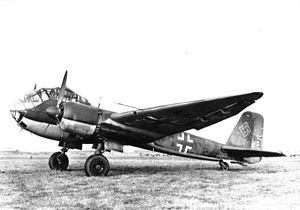Junkers Ju 188
| Junkers Ju 188 | |
|---|---|
 |
|
| Role | Tactical bomber/Reconnaissance aircraft |
| Manufacturer | Junkers |
| First flight | 1940 (Ju 88B V1) |
| Introduction | February 1943 |
| Retired | 1951 (France) |
| Primary users |
Germany France and United Kingdom (post-war) |
| Number built | 1,234 |
| Developed from | Junkers Ju 88 |
| Variants | Junkers Ju 388 |
The Junkers Ju 188 was a German Luftwaffe high-performance medium bomber built during World War II, the planned follow-up to the Ju 88 with better performance and payload. It was produced only in limited numbers, due both to the presence of improved versions of the Ju 88, as well as the increasingly effective Allied strategic bombing campaign against German industry and the resulting focus on fighter production.
In 1936, Junkers submitted proposals for the Ju 85 and Ju 88 into competition for the new standardized Luftwaffe high-speed tactical bomber, known as the Schnellbomber (fast bomber). The two designs were almost identical, differing only in that the Ju 85 used a twin-rudder and the Ju 88 a single fin. At the same time, they offered modified versions of each as the Ju 85B and Ju 88B, again similar to the original designs but using an "egg shaped" stepless cockpit forward fuselage design that comprised a greenhouse-like, well-framed network of some three dozen compound-curved window panels in total, another example of the "bullet-nose" design philosophy that almost all new German bomber designs exhibited, from the time of the Heinkel He 111P onwards. The new nose design for the Ju 88B also tightly integrated the forward end of the undernose Bola ventral gondola defensive gun position into the newer nose design, when compared to the "added-on" Bola unit pioneered on the Ju 88 V7 prototype. This meant the Ju 88B offered somewhat lower drag and better visibility. At the time, this was considered too radical and the Ju 88A with its simpler, separately-glazed dorsal cockpit "greenhouse" framed canopy, and "beetle's eye" framed, multi-flat panel nose glazing comprising a "stepped" cockpit design from the separation of the pair of glazed units by the sheetmetal of the upper fuselage nose winning the initial Schnellbomber production contract.
...
Wikipedia
